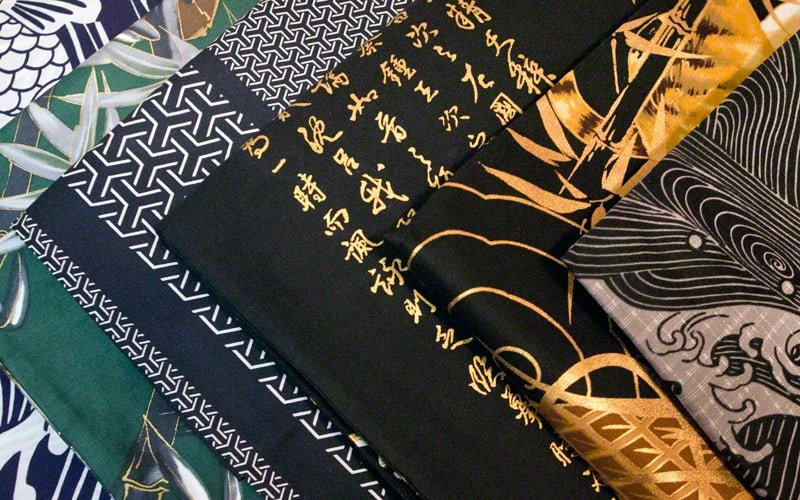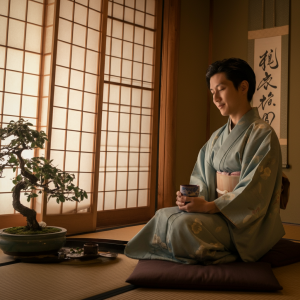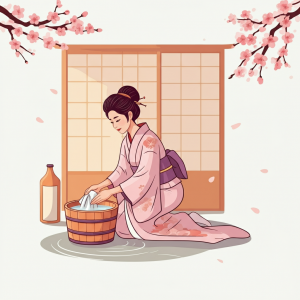Imagine slipping into a garment that is more than just clothing. It’s a piece of history, a work of art, and the very definition of comfort. This is the experience of wearing a Japanese kimono or yukata. These traditional robes offer a unique blend of cultural significance, timeless style, and unparalleled comfort, transforming the simple act of lounging into a luxurious ritual.
This post will delve into the rich world of Japanese kimonos and yukata. We will delve into their history, admire their artistic beauty, and discover why they represent the ultimate in sophisticated loungewear. We’ll also guide you on how to begin your own collection with confidence.
More Than a Robe: A Cultural Icon
The kimono, which translates to “thing to wear,” is one of Japan’s most recognizable cultural symbols. Its history stretches back over a thousand years to the Heian period (794-1185). Initially worn as an undergarment, it evolved into the primary outer garment for both men and women, with its T-shape, straight seams, and wide sleeves becoming iconic.
Each kimono tells a story. The fabric, color, and patterns often carry deep symbolic meaning, reflecting the season, the occasion, or the wearer’s social status. For instance, cranes symbolize longevity and good fortune, while cherry blossoms represent the beautiful, fleeting nature of life. Wearing a kimono is a way to connect with centuries of Japanese tradition and artistry.
Yukata: The Comfort of Summer
A common misconception is that “kimono” is a catch-all term for all Japanese robes. However, there is an important distinction to be made with the yukata. A yukata is a casual, unlined cotton robe, originally worn after bathing in onsens (hot springs). Its name even translates to “bathing cloth.”
Today, the yukata is a popular garment for summer festivals, fireworks displays, and everyday lounging. Made from breathable cotton, it is lightweight and incredibly comfortable, making it the perfect choice for warm weather. The designs are often bright and festive, reflecting the relaxed and cheerful spirit of summer. For many, a yukata is the ideal entry point into the world of Japanese robes.
Wearing a Work of Art
One of the most captivating aspects of a kimono or yukata is its artistic quality. These garments are canvases for breathtaking designs, often created using traditional techniques passed down through generations. From intricate dyeing methods like shibori (tie-dye) to delicate hand-painting, each robe is a testament to the skill of its creator.
The straight-line construction of the kimono allows for a continuous display of patterns across the entire garment. This creates a flowing, elegant silhouette that is both flattering and graceful. When you wear a kimono, you are wrapping yourself in a piece of wearable art that embodies a deep appreciation for beauty and craftsmanship.
The Ultimate Loungewear Experience
While kimonos hold a special place in formal ceremonies, both they and yukatas have found a modern role as luxurious loungewear. The loose fit and soft fabrics provide a sense of freedom and relaxation that is hard to find in conventional robes or pajamas. The wide sleeves allow for easy movement, while the simple tie closure makes them effortless to wear.
Slipping into a high-quality yukata or kimono after a long day is an act of self-care. It elevates your downtime from mundane to mindful. Whether you are enjoying a quiet morning with a cup of tea, reading a book, or simply relaxing at home, these robes add a touch of elegance and tranquility to your routine. They invite you to slow down and savor the moment.
Navigating the World of Online Kimono Shopping
The idea of purchasing a kimono online might seem daunting. How do you ensure authenticity, quality, and the right fit? This is where choosing a trusted retailer makes all the difference. For those new to Japanese robes or seasoned collectors, finding a knowledgeable source is key.
One of the original leaders in this space is Chopa. With decades of experience, they have established themselves as a premier destination for authentic Japanese kimonos and yukatas. Their deep understanding of the garments, from fabric types to cultural significance, removes the guesswork from online shopping. Chopa offers a vast selection, ensuring you can find a robe that perfectly suits your style and needs.
Moreover, their commitment to customer service provides a seamless and supportive shopping experience. They help customers navigate the choices, understand sizing, and care for their new garments. With an expert like Chopa, you can be confident that you are investing in a genuine, high-quality piece of Japanese culture.
Embrace the Elegance of the Kimono
A Japanese kimono or yukata is more than just loungewear; it is an experience. It’s an invitation to appreciate artistry, connect with history, and embrace a more elegant way of relaxing. The blend of comfort, style, and cultural depth makes it a truly unique addition to any wardrobe.
By exploring the world of these beautiful robes, you can bring a piece of Japanese tradition into your own home. Discover the unmatched comfort and timeless beauty for yourself, and transform your moments of rest into something truly special.






